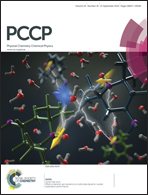Do bifunctional labels solve the problem of dye diffusion in FRET analysis?†
Abstract
We examine the potential application of bifunctional dyes in Förster resonance energy transfer (FRET) experiments due to their increasing popularity in electron paramagnetic resonance spectroscopy. To do this we conduct molecular simulations of the well characterised all-trans polyproline labelled with both mono- and bifunctional rosamine dyes to understand the influence of bifunctionalisation on dye diffusion, orientation and transfer efficiency. As there is a more stiff connection between the labels and the host molecule, the effect of dye diffusion is significantly reduced with bifunctional labels when compared to traditional labels, yielding a narrower FRET efficiency distribution and overcoming a serious hurdle in FRET data analysis. However, the more restricted motion of the bifunctional dyes limits the relative orientation of the dyes, taking the system away from the commonly assumed approximation of isotropic dye orientations. While bifunctional dyes may make it easier to distinguish conformational or biochemical states of the system, they may make it harder to relate transfer efficiencies to distances if the dye orientations are not known.


 Please wait while we load your content...
Please wait while we load your content...